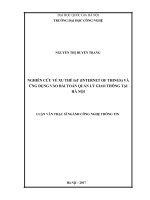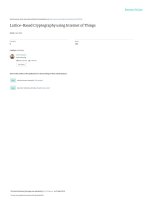assignment 1 unit 43 internet of things
Bạn đang xem bản rút gọn của tài liệu. Xem và tải ngay bản đầy đủ của tài liệu tại đây (755.99 KB, 40 trang )
<span class="text_page_counter">Trang 1</span><div class="page_container" data-page="1">
<b> ASSIGNMENT 1 FRONT SHEET</b>
</div><span class="text_page_counter">Trang 3</span><div class="page_container" data-page="3"><b>❒ Summative Feedback: ❒ Resubmission Feedback:</b>
</div><span class="text_page_counter">Trang 5</span><div class="page_container" data-page="5"><b>Internal Verifier’s Comments: </b>
<b>Signature & Date:</b>
</div><span class="text_page_counter">Trang 7</span><div class="page_container" data-page="7">I. <i>Introduction... 5</i>
II. <i>Explore various forms of IoT functionality (P1)... 5</i>
1. <i>Definition about IoT... 5</i>
</div><span class="text_page_counter">Trang 9</span><div class="page_container" data-page="9">I. Introduction
Advances in technology are making IoT adoption more widespread, from pill-shaped micro-cameras that can identify thousands of images of the inside of the body to smart sensors that can assess everything. Shallow baling, to smart home devices, is becoming popular. In this exercise, I will prove and prove IoT elements and features. Besides, analysis of preferred architectures, frameworks, tools, hardware, and APIs should be used during IoT development. Next, identifying and planning for an appropriate IoT software to use architectures, frameworks, tools, hardware, and APIs is not out of the ordinary. And finally, let's compare the brand new plans and structures of IoT applications.
II. Explore various forms of IoT functionality (P1).1. Definition about IoT
Since the coining of the term in 1999, the web of things (IoT) has transformed from a mere vision to a palpable reality. This can be attributed to the extensive use of the web Protocol (IP), the increase of ubiquitous computing, and the continued
advancement of data analytics, among other drivers of development. By 2020, it's estimated that there'll be 20.4 billion devices connected to the IoT. Despite its continuing expansion, but, the IoT remains to a point an obscure concept, something that’s often mentioned in abstract terms whilst it provide manifest benefits. The IoT is often described as an extension of the web and other network connections to different sensors and devices — or “things” — affording even simple objects, like lightbulbs, locks, and vents, a higher degree of computing and analytical capabilities. Interoperability is one of the key aspects of the IoT that contribute to its growing popularity. Connected or “smart” devices —as “things” within the IoT are often called — have the power to collect and share data from their environments with other devices and networks. Through the analysis and processing of the data, devices can perform their functions with little or no need for human interaction. Given the ever-increasing number ofconnected devices, the IoT continues its path of evolution, adding different layers to the info that's already being shared and processed, and giving rise to stylish algorithms that result in improved levels of automation. And because of the variability of “things” which will be connected thereto, the IoT has enabled diverse applications for individual users and full industries alike.
</div><span class="text_page_counter">Trang 10</span><div class="page_container" data-page="10">2. IoT work
</div><span class="text_page_counter">Trang 11</span><div class="page_container" data-page="11">An IoT ecosystem consists of web-enabled smart devices that use embedded systems, such as processors, sensors and communication hardware, to collect, send and act on data they get from their environments. IoT devices share the sensor data they collect by connecting to an IoT gateway or other edge device where data is either sent to the cloud to be analyzed or analyzed. Sometimes, these devices communicate with other related devices and act on the information they get from one another. The devices do most of the work without human intervention, although people can interact with the devices -- for instance, to set them up, give them instructions or access the data. The connectivity, networking and communication protocols used with these web-enabled devices depend on the specific IoT applications deployed. IoT can also make use of artificial intelligence (AI) and machine learning to aid in making data collecting processes easier and more dynamic.
</div><span class="text_page_counter">Trang 12</span><div class="page_container" data-page="12">Figure: IoT work
</div><span class="text_page_counter">Trang 13</span><div class="page_container" data-page="13">3. Applications of IoT
As the internet at large affects a broad spectrum of users, so does the IoT. Depending on the scale of connectivity and the number of devices involved, the IoT can have significant and specific applications, be they for a single user or an entire city. Common applications of the IoT include the following.
Smart Homes: One of the best and the most practical applications of IoT, smart homes really take both, convenience and home security, to the next level. Though there are different levels at which IoT is applied for smart homes, the best is the one that blends intelligent utility systems and entertainment together. For instance, your electricity meter with an IoT device giving you insights into your everyday water usage, your set-top box that allows you to record shows from remote, Automatic Illumination Systems, Advanced Locking Systems, and Connected Surveillance Systems all fit into this concept of smart homes. As IoT evolves, we can be sure that most of the devices will become smarter, enabling enhanced home security.
Figure: Smart home
Smart City: Not just internet access to people in a city but to the devices in it as well – that’s what smart cities are supposed to be made of. And we can proudly say that we’re going towards realizing this dream. Efforts are being made to incorporate connected technology into infrastructural requirements and some vital concerns like Traffic Management, Waste Management, Water Distribution, Electricity Management, and more. All these work towards eliminating some day-to-day challenges faced by people and bring in added convenience.
</div><span class="text_page_counter">Trang 15</span><div class="page_container" data-page="15">Figure: Smart city
Self-driven Cars: We’ve seen a lot about self-driven cars. Google tried it out, Tesla tested it, and even Uber came up with a version of self-driven cars that it later shelved. Since it’s human lives on the roads that we’re dealing with, we need to ensure the technology has all that it takes to ensure better safety for the passenger and those on the roads. The cars use several sensors and embedded systems connected to the Cloud and the internet to keep generating data and sending them to the Cloud for informed decision-making through Machine Learning. Though it will take a few more years for the technology to evolve completely and for countries to amend laws and policies, what we’re witnessing right now is one of the best applications of IoT.
Farming: Farming is one sector that will benefit the most from the Internet of Things. With so many developments happening on tools farmers can use for agriculture, the future is sure promising. Tools are being developed for Drip Irrigation, understanding crop patterns, Water Distribution, drones for Farm Surveillance, and more. These will allow farmers to come up with a more productive yield and take care of the concerns better.
4. IoT characteristics
</div><span class="text_page_counter">Trang 16</span><div class="page_container" data-page="16">There are the following characteristics of IoT as follows. Let’s discuss it one by one.
</div><span class="text_page_counter">Trang 17</span><div class="page_container" data-page="17">Connectivity - Connectivity is an important need of the IoT infrastructure. Things of IoT should be connected to the IoT infrastructure. Anyone, anywhere, anytime can connect, this should be guaranteed at all times. For example, a connectionbetween people through internet devices like mobile phones, and other gadgets, and also the connection between Internet devices such as routers, gateways, sensors, etc.
Intelligence and Identity - The extraction of knowledge from the generated data is very important. For example, a sensor generates data, but that data will only be useful if it is interpreted. Each IoT device has a unique identity. This
identification helps track the equipment and at times for querying its status.
Scalability - The number of elements connected to the IoT zone is increasing day by day. Hence, an IoT setup should be capable of handling the massive expansion. The data generated as an outcome is enormous, and it should be handled.Dynamic and Self-Adapting (Complexity) - IoT devices should dynamically adapt themselves to the changing contexts and scenarios. Assume a camera meant for the surveillance. It should be adaptable to work in different conditions and different light situations (morning, afternoon, night).
Architecture - IoT architecture cannot be homogeneous. It should be hybrid, supporting different manufacturers ‘ products to function in the IoT network. IoT is not owned by anyone engineering branch. IoT is a reality when many domains come together.
Safety - There is a danger of the sensitive personal details of the users getting compromised when all/devices are connected to the internet. This can cause a loss to the user. Hence, data security is a major challenge. Besides, the equipment involved is huge. IoT networks may also be at the risk. Thus, equipment safety is also criticalIII. Review standard architecture, frameworks, tools, hardware and APIs available for use in IoT development (P2) (P3).
1. Architectures
Due to the ever-evolving nature of IoT devices, and the wide diversity of sensors, there is no one-size-fits-all architecture for IoT projects. But, some of the building blocks will be similar from project to project.First, you will need to build with scalability in mind. The amount of data that you will collect over time will take on enormous proportions and you will need a platform that canaccommodate this in the long run.You will also need to ensure that you have high availability at any given time. Having system failures could make you lose some business in the best case, or could have fatal consequences in the worst cases.Finally, you will need a system that is flexible enough to accommodate quick and frequent changes. As your architecture evolves, or your
</div><span class="text_page_counter">Trang 18</span><div class="page_container" data-page="18">business needs to change, you will need to iterate without breaking the existing architecture.
</div><span class="text_page_counter">Trang 19</span><div class="page_container" data-page="19">The three-layer architecture has been the dominant model for IoT applications. The three layers are Perception (or Devices), Network, and Application.
</div><span class="text_page_counter">Trang 21</span><div class="page_container" data-page="21">Perception: The sensors themselves are on this layer. This is where the data comes from. The data could be gathered fromany number of sensors on the connected device. Actuators, which act on their environment, are also at this layer of the architecture.
Network: The network layer describes how large amounts of data are moving throughout the application. This layer connects the various devices and sends the data to the appropriate backend services.
Application: The application layer is what the users see. This could be an application to control a device in a smart-home ecosystem, or a dashboard showing the status of the devices which are part of a system.
Another way to describe an IoT solution architecture is using a four-stage approach. This architecture describes the various building blocks that constitute the IoT solution. In this scenario, more emphasis is put on edge computing than on the other proposed designs.
Devices: This stage is about the actual devices in the IoT solutions. These devices could be sensors or actuators in the Perception layer. Those devices will generate data (in the case of sensors) or act on their environment (in the case of actuators). The data produced is converted into a digital form and transmitted to the internet gateway stage. Unless a critical decision must be made, the data is typically sent in a raw state to the next stage due to the limited resources of the devices themselves.
</div><span class="text_page_counter">Trang 23</span><div class="page_container" data-page="23">Internet gateways: The internet gateway stage will receive the raw data from the devices and pre-process it before sending it to the cloud. This internet gateway could be physically attached to the device or a stand-alone device that could communicatewith sensors over low-power networks and relay the data to the internet.
Edge or fog computing: To process data as quickly as possible, you might want to send your data to the edge of the cloud. Thiswill let you analyze the data quickly and identify if something requires immediate attention. This layer typically would only be concerned with recent data that is required for time-critical operations. Some pre-processing might be done at this stage, too,to limit the data that is ultimately transferred to the cloud.
Cloud or data centre: In this final stage, the data is stored for later processing. The application and business layers live in this stage, where dashboards or management software can be fed through the data stored in the cloud. Deep analysis or
resource-intensive operations such as machine learning training will happen at this stage.2. Framework
An IoT framework is a middleware layer beneath one or more IoT applications that presents a network-facing application interface through which peer framework nodes interact. Frameworks often support multiple communication technologies and message passing techniques.
The IoT Framework is comprised of four major components, as discussed below:
Device Hardware - The device hardware component of the IoT framework requires some basic knowledge on architecture.The user is also required to have an idea on the working of the different micro-controllers, as well the sensors.
Device Software - In order for the device software of the IoT framework to function properly, the included writing applications are required to configure the controller, then operate them remotely. The user is required to have a basic understanding of how an API works inside the micro-controllers, as well how libraries are usually made for programming.
</div><span class="text_page_counter">Trang 25</span><div class="page_container" data-page="25">Communication and Cloud Platform - The cloud platform is one of the most crucial parts of the IoT framework. It calls for the basic knowledge of all communication, whether wireless or wired. The user is also required to have a good
understanding of IoT integration, as well as the working of the cloud technology. In summary, we can say the communication and Cloud Platform of the IoT Framework is where all communications happen.
Cloud Application - The cloud application is a type of software program, which mainly consists of components that can be accessed quite easier and faster. These components can be either local or even cloud-based. The cloud application works to improve the system, such that its maximum potential is realized. In other words, the cloud application can be defined as the written application of an IoT framework, that binds all the local hardware devices, as well as the cloud-based devices.
3. Tools
The IoT phenomenon is all around us: it’s made up of the ordinary objects we use at home, at work, or in the streets; the difference is that all these objects and devices are now computerized. They have network connectivity and embedded software, can interact with phones and other gadgets, receive and send information, and be controlled by a user. In today's internet-driven world, IoT has engulfed the IT industry and is the latest buzzword. It has opened up new horizons for companies and developers working on IoT. Many special products have been developed due to the development of IoT applications. Internet of Things solutions companies is creating hardware and software designs to help IoT developers create new and remarkable IoT devices and applications.
Arduino - Arduino is the leading company in the IoT market that produces electronic devices and software for them. Arduino hardware offerings include microcontroller boards, modules, shields and kits. Hardware specifications are suitable for creating various projects, such as robotics and home automation.
</div>








